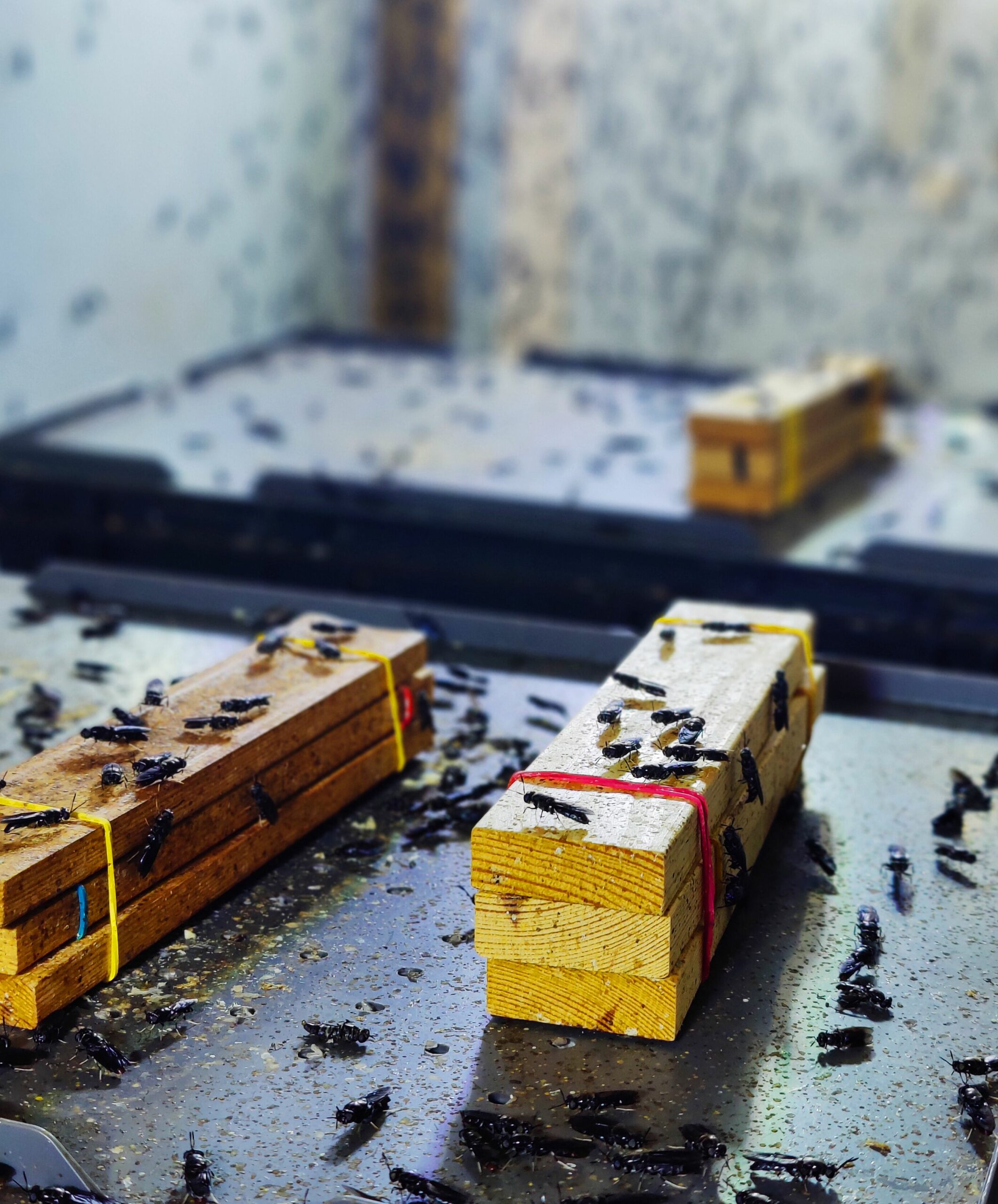
Manna Insect Global Insect Industry Survey spring 2023
At Manna Insect, we have surveyed Black Soldier Fly farmers and enthusiast to better understand the issues, opportunities as well as the current insect industry status better. In this post we reflect the results of the first global insect industry survey that we ran during the 1st half of 2023.
Geography and production size
We had 120+ respondents to the survey, and the 1st interesting revelation relates to exactly that. They came from 46 different countries across the globe, so it is easy to come to a conclusion that the interest towards BSF rearing is a global phenomena that seems to be picking up nicely across almost all continents, only South America seemed to be mostly absent from the survey, only 1 respondent came from South America, from Chile to be exact. Asia and Africa were the hot spots, which came as no surprise.
The 2nd find was to realize that even if the factory-scale insect protein producers are filling our news feeds, the size of production was equally present in the survey from small time producers to bigger scale professional production, all the way from producing 1,5 kilograms of BSF larvae per month to producing 50.000 kg of larvae per month. Most typically the production levels were ranging from 10-120 kg at lower scale and from 500 to 3.500 kg per month at high end, with few exceptions at both ends of the scale.
Similarly the respondents were widely scattered along the scale of upcycling 10 kilos of biowaste per month to over 1 million kilos (1.000 tons) per month. There were many small scale farmers present, but typically respondents were upcycling 500-3.000 kgs at lower end of scale, or 9.000-60.000 kgs of biowaste per month at higher end, with a few much bigger scale responses. Again, an easy conclusion is that we need to support all size insect rearing operations, from backyard outdoor rearing cages to container-size professional production and the factory-size operations, insect rearing happens all over the world in various sizes.
Industry-wise there were numerous industries represented where respondents came from, but agriculture / farming and aquaculture were both strongly present, as was research field. It may of course be difficult to identify the industry when you’re generally rearing insects, but traditional agriculture and fish farming were both clearly active industries.
The most common obstacles
The most common obstacles that the insect rearing industry faces these days are related to funding. Almost 1/3 of all respondents reported that they had not yet acquired reasonable funding to get started rearing insects at professional level. The 2nd most common obstacle was not having enough knowledge to start the operations, followed closely by the 3rd obstacle of needing and looking for training to better understand the rearing and breeding practices and the business case.
The next most common obstacles in insect rearing were “not sure where to get suitable or affordable biowaste”, “No business case yet for the larvae and/or frass”, “Not big enough customers yet”, “Haven’t done calculations yet to test the business case” and “Legislation missing or prohibiting use of insects or upcycling of biowaste”, which all were reported as an obstacle by every 5-6th respondent.
Other obstacles the respondents mentioned were e.g. “Finding time or taking too much time to setting things up”, “Lack of knowledgeable workforce or generally lack of workforce”, “Trials and feasibility studies”, “Cost of energy” and “Understanding of which equipment to use”.
Size and type of operations
One of our questions was “Which size insect industry operation are you planning to operate or operate currently”, and the most common response was “Semi-professional facility with multiple rearing or breeding cages” with 25 % of all respondents, 23 % claimed to operate rearing/growth container, 19 % had backyard shed or cages outdoors, 16.5 % were involved in a factory-size operation, and finally 16 % were operating a breeding container.
We asked our survey respondents what they use or plan to use insects for, and the most common use case – even if not far ahead of other cases – was producing insect protein to be used as animal feed or part of a diet. Perhaps the response choices were a bit overlapping, as the next most common use cases were respectively related to poultry / chicken farming, for fish farming / aquafeed, and producing animal feed with live larvae.
The next use case was already less common: upcycling biowaste, and the next ones significantly less common use cases; for pet food, pressing BSF oil, for pigs, and finally feed for other animals.
Price of the biowaste
107 respondents replied to this question, and out of them 52 said they were getting the biowaste for free. This is really interesting, as we’ve heard it time and again, that especially in operations situated in Europe, insect farmers actually have to pay to get relevant biowaste for their operation. In some countries the competition for biowaste is really tough, e.g. biogas is becoming big and taking in all the biowaste they can get. Thus, insect farmers have to pay to get relevant substrate for their insects.
28 respondents said that they have to pay for the biowaste, and 6 were actually getting paid to remove someone else’s biowaste. 21 respondents were upcycling their own biowaste.
And the price for biowaste varied significantly among those that had to pay for it. Even if many forgot to name the currency they reported the price on, we saw numbers ranging from 25-2000 USD per ton. It is of course impossible to know at this point the quality and composition of the waste, and if the price includes e.g. transportation, but it becomes clear that some farmers are paying a top dollar for their waste, while in other countries farmers get it for free, which makes comparing business cases between countries difficult – perhaps even irrelevant.
Especially in developing countries there is often biowaste available for free, as long as you transport it on your own expense, but at the same time the chicken feed or fish feed may also be cheap compared to countries where the biowaste is expensive to acquire.
That said, it is good to remember, that as long as the operation is local, the business case calculations are easy, but whenever you need to take into account transportation costs, possible tolls or other export costs, storing, additional salaries, etc., the business case is much too often lost. Which is actually one of the most important reasons why Manna Insect’s solutions are focusing on upcycling local waste to be turned into locally usable animal feed and fertilizer, thus giving a local farmer a greater possibility to make additional income from insects or to at least save in feed and fertilizer costs and make their farm more profitable.
Sources of information
The most commonly used sources for insect rearing information were Google and more generally Internet, with Linkedin also being mentioned often. The next most common sources were research / scientific papers, and YouTube. Surprisingly Facebook Groups were not commonly used, even if many of those have significant numbers of users.
The events that respondents often visited or planned to visit were in wide range from local animal, agriculture, biology, biotech, hydro-phonics and insect events, and the most often named individual event was Insects to Feed the World (IFW) conference.
The most interesting companies and business cases
The participants saw that the most interesting companies in the insect industry were Ynsect with 11 mentions, Manna Insect with 10 mentions, Protix with 8, InnovaFeed with 6, and FreezeM with 3 mentions. None of the other industry players gained but 2 or less mentions. From Manna Insect’s part, Thank You, we’re very glad we’ve been noticed among the big players!
And finally, by far the most interesting business cases in the insect industry were producing insect protein for animal feed, followed closely by producing feed for fish and aquaculture. The next most interesting business cases were insect protein for pet food, frass (fertilizer), and getting paid to remove someone else’s biowaste. Quite far behind were a chance to upcycle local waste for local (own) use (for cost savings), extracting chitin for biomedical use, and pressing bio-oils out of BSF.
Thank You for all respondents! We have sent the full results to you (in case you left us your contact details), and we will most likely run a similar insect industry survey again later this year, so remember to join that as well! Meanwhile, remember to follow our company profile in LinkedIn for a bunch of BSF farming and insect business related content!
